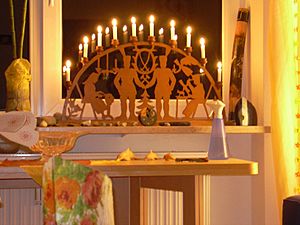Schwibbogen facts for kids
A schwibbogen is a special candle holder from the Ore Mountains region in Germany. It looks like an arch and is used for decoration, especially around Christmas. The word "schwibbogen" comes from an old German word meaning "to hover."
The first metal schwibbogen was made in 1740 in a town called Johanngeorgenstadt. Early designs were often made from a single piece of black metal and could be painted. The number of candles on a schwibbogen changes with its size. The very first designs held eleven candles.
What is a Schwibbogen?
The design of the schwibbogen is closely linked to the mining history of the Ore Mountains. Miners often worked deep underground, especially in winter, where they didn't see much daylight. The schwibbogen, with its glowing candles, became a symbol of light and hope.
It likely started as a candle holder used during the "Christmas shift" (Mettenschicht). This was a special dinner for miners, their foremen, and the smiths who made their tools. The symbols on the schwibbogen often show things important to the miners' lives and hopes.
Famous Schwibbogen Designs
A very famous schwibbogen design was created by Paula Jordan in 1937. This design showed the main ways people earned money in the region during the 18th and 19th centuries. It featured:
- Two miners
- A wood carver
- A bobbin lace maker
- A Christmas tree
- Two miner's hammers
- Two crossed swords
- An angel
This design typically holds seven candles. Even though some people think otherwise, the schwibbogen has always been connected to Christmas. The light from the candles showed the miners' wish for daylight during the long, dark winter months. During the Christmas shift, the lights also represented the safety lamps of all the miners who had finished a year of hard and often dangerous work.
Modern Schwibbogen Styles
After World War II, the schwibbogen became even more popular. Its look also changed a lot. Today, most schwibbogen are made from wood. They often show historical events or religious scenes. You can also find designs with landscapes, city skylines, or even advertisements. However, they usually still keep some connection to Christmas traditions.
In the Ore Mountains, it's common to see a lit schwibbogen in the windows of houses during winter. These often have traditional designs or show local scenes. The town of Seiffen is especially known for making beautiful schwibbogen in its craft shops.
See also
 In Spanish: Schwibbogen para niños
In Spanish: Schwibbogen para niños
- Wooden toymaking in the Ore Mountains


